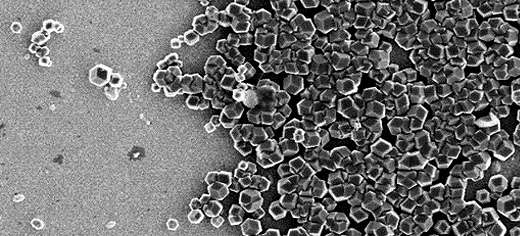Bacterial builders on site for computer construction
Published Friday 4th May 12

Forget computer viruses - magnet-making bacteria could be used to build tomorrow's computers with larger hard drives and speedier connections.
Researchers at the University of Leeds have used a type of bacterium which 'eats' iron to create a surface of magnets, similar to those found in traditional hard drives, and wiring. As the bacterium ingests the iron it creates tiny magnets within itself.
The team has also begun to understand how the proteins inside these bacteria collect, shape and position these "nanomagnets" inside their cells and can now replicate this behaviour outside the bacteria.
Led by Dr Sarah Staniland from the University's School of Physics and Astronomy, in a longstanding collaboration with the Tokyo University of Agriculture and Technology, the team hope to develop a 'bottom-up' approach for creating cheaper, more environmentally-friendly electronics of the future.
Dr Staniland said: "We are quickly reaching the limits of traditional electronic manufacturing as computer components get smaller. The machines we've traditionally used to build them are clumsy at such small scales. Nature has provided us with the perfect tool to circumvent this problem."
The magnetic array was created by Leeds PhD student Johanna Galloway using a protein which creates perfect nanocrystals of magnetite inside the bacterium Magnetospirilllum magneticum. In a process akin to potato-printing on a much smaller scale, this protein is attached to a gold surface in a checkerboard pattern and placed in a solution containing iron.
At a temperature of 80°C, similarly-sized crystals of magnetite form on the sections of the surface covered by the protein. The team are now working to reduce the size of these islands of magnets, in order to make arrays of single nanomagnets. They also plan to vary the magnetic materials that this protein can control. These next steps would allow each of these nanomagnets to hold one bit of information allowing the construction of better hard drives.
"Using today's 'top-down' method - essentially sculpting tiny magnets out of a big magnet - it is increasingly difficult to produce the small magnets of the same size and shape which are needed to store data," said Johanna Galloway. "Using the method developed here at Leeds, the proteins do all the hard work; they gather the iron, create the most magnetic compound, and arrange it into regularly-sized cubes."
A different protein has been used to create tiny electrical wires by Dr Masayoshi Tanaka, during a secondment to Leeds from Tokyo University of Agriculture and Technology. These 'nanowires' are made of 'quantum dots' - particles of copper indium sulphide and zinc sulphide which glow and conduct electricity - and are encased by fat molecules, or... ( more at http://www.leeds.ac.uk/news/article/3181/bacterial_builders_on_site_for_computer_construction )
Nenhum comentário:
Postar um comentário